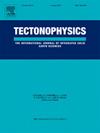The fingerprint of structural inheritances in the W-Pyrenees revealed by machine learning detection of seismicity
IF 2.7
3区 地球科学
Q2 GEOCHEMISTRY & GEOPHYSICS
引用次数: 0
Abstract
The orogenic evolution of the western Pyrenees and its relationship with ancient rift architecture are well-studied and therefore represent a natural laboratory for investigating the link between structural inheritance and the distribution of present-day seismicity. In this study, we use an automated method to detect and pick P and S waves from local earthquakes to characterize the distribution of seismicity in the region. The P and S picks are used to obtain a catalog of earthquakes and to perform a local earthquake tomography. We analyze 2-D sections and depth slices of the tomographic model and of the seismicity catalog, and confront them to the 3-D geological architecture of the inverted Mauléon rift system. Our results reveal that present-day deformation is mainly extensional, with a main cluster of aligned, steeply north-dipping seismicity localized along the former rift necking domain. In addition, the rift-inherited NNE-SSW Saison and Barlanès transfer zones either offset or disrupt the seismicity cluster and delimit three seismically active segments. The Chaînons Béarnais segment shows localized seismicity, whereas the eastern and western Mauléon segments show a westward extension of earthquake distribution in relation with the widening of both the orogenic wedge and the mantle body preserved at shallow depth. Our results suggest that the rift-inherited necking zone played a predominant role in the localization of the deformation during both orogenic and post-orogenic evolution, and as such represents a critical zone for seismic hazard assessment. Earthquakes diffusely distributed in and around the high-velocity mantle body could be partly related to ongoing serpentinization.
利用机器学习检测地震活动性揭示的w -比利牛斯山脉结构遗传指纹
西比利牛斯山脉的造山演化及其与古裂谷构造的关系得到了很好的研究,因此为研究构造继承与当今地震活动分布之间的联系提供了一个天然的实验室。在这项研究中,我们使用一种自动化的方法来探测和提取当地地震的P波和S波,以表征该地区地震活动的分布。P和S选择用于获得地震目录并进行局部地震层析成像。我们对层析模型和地震活动目录的二维剖面和深度切片进行了分析,并将其与倒转的毛尔松裂谷系的三维地质构造进行了对比。我们的研究结果表明,现今的形变主要是张拉性的,在以前的裂谷颈缩域中有一组排列整齐的、陡北倾的地震活动。此外,裂谷继承的NNE-SSW Saison和barlan转移带抵消或破坏了地震活动群,并划分了三个地震活跃段。cha nons bsamarnais段显示局部地震活动性,而maulsamais东部和西部段显示地震分布向西扩展,这与造山带楔体和浅埋地幔体的加宽有关。我们的研究结果表明,裂谷继承颈缩带在造山和造山后演化过程中对变形的局部化起着主导作用,因此是地震危险性评估的关键地带。高速地幔体内部和周围弥散分布的地震可能与正在进行的蛇纹岩化有关。
本文章由计算机程序翻译,如有差异,请以英文原文为准。
求助全文
约1分钟内获得全文
求助全文
来源期刊

Tectonophysics
地学-地球化学与地球物理
CiteScore
4.90
自引率
6.90%
发文量
300
审稿时长
6 months
期刊介绍:
The prime focus of Tectonophysics will be high-impact original research and reviews in the fields of kinematics, structure, composition, and dynamics of the solid arth at all scales. Tectonophysics particularly encourages submission of papers based on the integration of a multitude of geophysical, geological, geochemical, geodynamic, and geotectonic methods
 求助内容:
求助内容: 应助结果提醒方式:
应助结果提醒方式:


